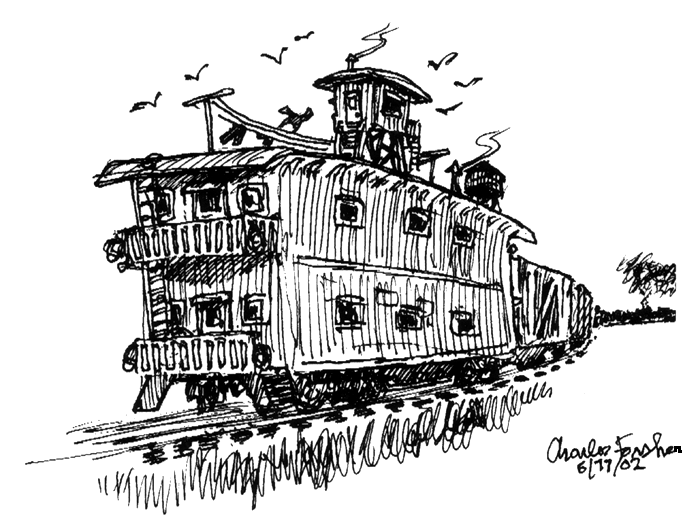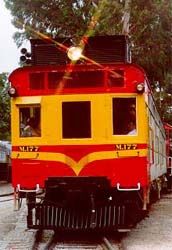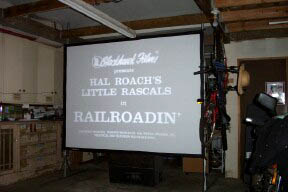ASSOCIATES MAILBAG
From Associate no. 40 Paul Nelson (Alton, CA):
An editorial appeared in the winter issue of The Headlight. I no longer have the issue at hand, so I'm going on recollection.
As I recall, the editorial offered a hypothesis for the motive on the part of the City to get SCSRA track and other materials out of Travel Town. That hypothesis was that the City never really intended to construct the Zoo Line. (Perhaps the Zoo Line idea was developed as a public relations gimmick: a lot of hype at little if any expense.)
At this point I'll enter my own extrapolation of events.
The City was caught off guard when the SCSRA took the construction ball and ran with it. We were unexpectedly successful, gathering materials and forming an enthusiastic track gang. When the SCSRA said "When do we start?," the City, knowing the real answer was "never," had to scramble. The City could not fall back on the usually safe "When the budget permits" fiscal explanation. No. The City was offered free labor and equally free materials to initiate and (one would think) complete the job.
Without going into a conspiracy mentality I'll suggest the City decided the best way to handle the situation was to make life difficult for us for some period of time. When things deteriorated enough the City would simply demand that the SCSRA remove all track materials (and anything else the City wanted to eliminate) from Travel Town. And, oh-by-the-way, let's wrest track maintenance away from the SCSRA so the labor force has nothing to do and disappears.
I actually think this could be a viable scenario. And given the lack of explanation from the City for our treatment it's as good as any.
If my hypothesis is correct, the treatment we received from the City is our own damn fault. I submit that if the SCSRA had kept to its original mandate to attend to the M.177 we wouldn't be Travel Town pariahs. Our Maintenance-of-Way department would have been assigned one function: keep enough track in shape to operate within Travel Town.
At this point I'm going to hear the same old story about keeping the weekend volunteer force happy by letting them do what they want. No deal this time. This philosophy has failed. I obviously don't know what percentage of the weekend workforce participate in M.177 renovation versus other activities, but I can guess: low.
I was a regular Saturday volunteer back in the mid-to-late 1980s. I remember what the M.177 looked like then. The passenger and baggage compartments were completely raw (i.e., unrestored). The engine was out, large components were detached and Chell Hurdle was sandblasting some of them. The only restored area was the bathroom in the rear.
When I visited Travel Town in August of 2001 and received a tour of the M.177 I was frankly shocked by the lack of progress in the interior compartments. (Remember, I'm looking at the M.177 about 12 years after I moved out of the region.) Oh sure, the front was painted, the engine was in place and the engine compartment the darling showpiece. But the rest was unchanged. What bothered me the most about the lack of progress is that interior compartment renovation is a labor, not cost, intensive activity. The SCSRA has far more labor than money. It was nice to get the engine completed but that was cost driven. I think that in the same amount of time the labor driven interior compartments would have also seen some effort, if not been completed. I saw none.
I submit that not only has the diverse workforce philosophy failed, but has been detrimental to the still espoused primary goal of renovating the M.177. It's time the Board wake up to this and take corrective action or give up on the M.177.
And here's another thought: Has it occurred to anyone that the lack of progress on the interior is why the City wants us out? This explanation is far more likely than the Zoo Line thesis.
No matter what the explanation is, I suggest the Board take one of two actions:
- Approach the City. Offer to return to Travel Town and work exclusively on the M.177 and provide operations manpower if the City wants it. No track, no Charley, no steam, no cabeese, no nothing. (Since the cabeese apparently belong to us, give them to the City.) Only the M.177 and operations.
"What?" You'll say. "If we mandate work on the M.177 we won't have a volunteer force!" We don't have a volunteer force NOW!
Does anyone work on the M.177 these days? What has the SCSRA got to lose?
- Officially adopt a new policy that states that the SCSRA is abandoning the M.177 as a project and is going to move on in other directions.
As a member I suggest option 1. It's becoming increasingly difficult to accept the direction the Board is taking the SCSRA. My goal is to return to Travel Town and the M.177. We need to go THERE, not to Fullerton.
Sue Kientz responds:
Paul, thank you for your letter.
As to your hypothesis about our troubles, the idea of us railroading the City into the Zoo RR doesn't hold up when you consider the time period of events. The Zoo RR was in the Travel Town Master Plan for years and years. It wasn't just our idea, and the effort heavily interested the City enough to have them give LALS special consideration in their lease if they would allow the Zoo RR passage through that property.
Also, focussing on the M.177 exclusively as a project would be much more attractive if access to M.177 was not so difficult as it is during the current construction. Also it would be more attractive if the atmosphere at the park were different (as in, I brought my Mom over there a few months ago and she was taken aback at the people who walked past me without greeting me or answering a greeting. We were treated like pariahs. Most uncomfortable.) And lastly, it would be possible to make that our only focus if we did not have such promising activities and people who actually appreciate us, in Fullerton.
Along with others like Gordon who remember you when you were here physically, helping with M.177, I truly value that you have stuck with SCSRA all this time, even while living farther away. You must appreciate, however, that you do live far from the fray, and may not really understand all that we have been going through. I myself had to be convinced that there was a real problem, when this whole thing began. I went to meetings with the best intentions of getting things straightened out, and I soon learned that this was not other people's paranoia or imagination, that there was something going on that was making us undesirables. But there's only so much we can print in the Headlight, to make others understand.
Perhaps you are right about the lack of progress on M.177, that that influenced the City about us. We are actually trying to get back on track with that project. But I see no reason to limit ourselves to just that project, especially when the associates here in the area are very excited about our Fullerton plans. We are the Southern California Scenic Railway Assn., not the Motorcar Group or Travel Town Assn. We can be bigger than we have been, especially with our alliance with the FRPA.
Don't think your support has been in vain. Things are happening, but I can understand how you may feel dismayed at the last year or two. So am I! It's been an awful year, and I have tried so hard to do the right thing by SCSRA, that it's been a strain on my family life and my health. So have others. We aren't making any money here. The people who are volunteering are trying to do something good for others, and to preserve the trains.
In the long run, this time will seem just a turn of the corner. Hope you can hang in there with us while we make this turn, because things are really looking good down the line.
From Associate no. 241, Charles Forsher:
It has come to my attention that some controversy has arisen over parts of my Caboose speech (printed in the Spring 2002 Headlight as “History of the Caboose”).
So to clarify two points of the speech:
- How many brakemen can you put on the head of a pin? The speech started out as a reference to historical equipment, such as the Harbor Locomotives (L.A.H.D.) that had been spotted, for instance, near the start and end of the Caboose Ride. Mr. Bachlund pointed out that this would not be a permanent situation, so I started looking for “filler” in the speech.
One Caboose Operation Day, a very old man who claimed to have been a brakeman insisted that on the road he worked on, 16 people slept and ate and worked in the crummy he shared with them.
We know that some cabeese were scratch built, and it may be possible that somewhere in the United States there was a hybrid between a caboose, and an 1890s bunk car.
There were for awhile in New York double decked trolley cars that were virtual battle ships on flanged wheels, so a “monster caboose” may have existed, given that the road in question had no steep grades or tunnels to traverse, as this monster caboose must have both looked ungainly as well as posed a distinct danger to the balance of the freight train it was attached to (see Charles’ artistic depiction below!). This may be why few were built, and why none were manufactured commercially.

On the other hand, some cruel system of operation may have had the brakemen sleeping in shifts, as I have heard is the case in the armed forces.
In any event, the information sounded entertaining, so I added it to my new format, the rest of which came from the memories and accumulated knowledge of other volunteers. It must have worked as no one group of passengers conspired to eject me from the caboose I was attending.
- The Westinghouse Factor. One evening while watching my favorite TV channel (The History Channel) there was a program on modern marvels, and George Westinghouse was given his five minutes of fame.
What the author of the story I was watching failed to mention, apparently, was Mr. Westinghouse’s struggle to get any road to accept his radical air brake invention. All that was said was that George Westinghouse sold the idea at a certain date. This is what editing does, folks, and so I took the information at face value, adding it to my speech, with what may have been an intuitive twist:
“Imagine hearing about brakes that would stop a whole freight train, working on AIR, in 1890!”
Imagine, also, somebody standing over your shoulder at a video game in 1971, and telling you matter-of-factly that in a short time, most everybody in the U.S. would have SIMILAR technology in their homes for writing letters and other forms of office work.
The story of cabeese in its entirety would have far exceeded the noise-free traveling time that I had to deliver the speech I had so lovingly prepared, and if any of you have seen our safety video, you’ve seen at the end the futility of starting the speech BEFORE all of the tootling necessary for getting under way.
Perhaps when caboose operations resume, the journey will be long enough to accommodate the entire history of the cabeese in as accurate a format as possible.



